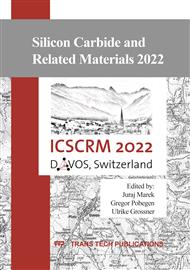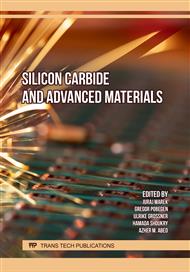[1]
D. Perovic, M. Castell, A. Howie, C. Lavoie, T. Tiedje, and J. Cole, "Field-emission SEM imaging of compositional and doping layer semiconductor superlattices," Ultramicroscopy, vol. 58, no. 1, pp.104-113, 1995.
DOI: 10.1016/0304-3991(94)00183-n
Google Scholar
[2]
C. P. Sealy, M. R. Castell, and P. R. Wilshaw, "Mechanism for secondary electron dopant contrast in the SEM," Journal of Electron Microscopy, vol. 49, no. 2, pp.311-321, 2000.
DOI: 10.1093/oxfordjournals.jmicro.a023811
Google Scholar
[3]
S. L. Elliott, R. F. Broom, and C. J. Humphreys, "Dopant profiling with the scanning electron microscope-A study of Si," Journal of Applied Physics, vol. 91, no. 11, pp.9116-9122, 2002.
DOI: 10.1063/1.1476968
Google Scholar
[4]
P. Kazemian, C. Rodenburg, and C. Humphreys, "Effect of experimental parameters on doping contrast of Si p-n junctions in a FEG-SEM," Microelectronic Engineering, vol. 73-74, pp.948-953, 2004.
DOI: 10.1016/s0167-9317(04)00249-7
Google Scholar
[5]
M. Buzzo, M. Ciappa, and W. Fichtner, "Imaging and dopant profiling of silicon carbide devices by secondary electron dopant contrast," IEEE Transactions on Device and Materials Reliability, vol. 6, no. 2, pp.203-212, 2006.
DOI: 10.1109/tdmr.2006.876605
Google Scholar
[6]
P. Kazemian, S. A. M. Mentink, C. Rodenburg, and C. J. Humphreys, "High resolution quantitative two-dimensional dopant mapping using energy-filtered secondary electron imaging," Journal of Applied Physics, vol. 100, no. 5, p.054901, 2006.
DOI: 10.1063/1.2335980
Google Scholar
[7]
D. Cooper, R. Truche, P. Rivallin, J.-M. Hartmann, F. Laugier, F. Bertin, A. Chabli, and J.-L. Rouviere, "Medium resolution off-axis electron holography with millivolt sensitivity," Applied Physics Letters, vol. 91, no. 14, p.143501, 2007.
DOI: 10.1063/1.2794006
Google Scholar
[8]
M. Dapor, B. J. Inkson, C. Rodenburg, and J. M. Rodenburg, "A comprehensive Monte Carlo calculation of dopant contrast in secondary-electron imaging," EPL (Europhysics Letters), vol. 82, no. 3, p.30006, 2008.
DOI: 10.1209/0295-5075/82/30006
Google Scholar
[9]
I. Volotsenko, M. Molotskii, Z. Barkay, J. Marczewski, P. Grabiec, B. Jaroszewicz, G. Meshulam, E. Grunbaum, and Y. Rosenwaks, "Secondary electron doping contrast: Theory based on scanning electron microscope and Kelvin probe force microscopy measurements," Journal of Applied Physics, vol. 107, no. 1, p.014510, 2010.
DOI: 10.1063/1.3276090
Google Scholar
[10]
A. K. W. Chee, R. F. Broom, C. J. Humphreys, and E. G. T. Bosch, "A quantitative model for doping contrast in the scanning electron microscope using calculated potential distributions and Monte Carlo simulations," Journal of Applied Physics, vol. 109, no. 1, p.013109, 2011.[11] A. K. W. Chee, "Quantitative Dopant Profiling by Energy Filtering in the Scanning Electron Microscope," IEEE Transactions on Device and Materials Reliability, vol. 16, no. 2, pp.138-148, 2016.
DOI: 10.1063/1.3524186
Google Scholar
[12]
Y. Aizawa, T. Sato, T. Sunaoshi, H. Matsumoto, T. Agemura, S. Torikawa, I. Nakatani, and M. Kiyohara, "High Contrast SEM Observation of Semiconductor Dopant Profile using TripleBeam® System," Microscopy and Microanalysis, vol. 23, no. S1, pp.1508-1509, 2017.
DOI: 10.1017/s1431927617008200
Google Scholar
[13]
W. Han, A. Srinivasan, A. Banerjee, M. Chew, and A. Khursheed, "Beyond conventional secondary electron imaging using spectromicroscopy and its applications in dopant profiling," Materials Today Advances, vol. 2, p.100012, 2019.
DOI: 10.1016/j.mtadv.2019.100012
Google Scholar
[14]
Z. Zhang and J. T. Yates, "Band Bending in Semiconductors: Chemical and Physical Consequences at Surfaces and Interfaces," Chemical Reviews, vol. 112, no. 10, pp.5520-5551, 2012.
DOI: 10.1021/cr3000626
Google Scholar
[15]
M. L. M. Larry A. Coldren, Scott W. Corzine, Gain and Current Relations, ch. Four, pp.157-246. John Wiley & Sons, Ltd, 2012.
Google Scholar
[16]
K. L. Mletschnig, M. Rommel, G. Pobegen, W. Schustereder, and P. Pichler, "Aluminum Activation in 4H-SiC Measured on Laterally Contacted MOS Capacitors with a Buried CurrentSpreading Layer," Materials Science Forum, vol. 1062, pp.38-43, 2022.
DOI: 10.4028/p-sg9dq0
Google Scholar
[17]
J. F. Ziegler, M. Ziegler, and J. Biersack, "SRIM - The stopping and range of ions in matter (2010)," Nuclear Instruments and Methods in Physics Research Section B: Beam Interactions with Materials and Atoms, vol. 268, no. 11, pp.1818-1823, 2010.
DOI: 10.1016/j.nimb.2010.02.091
Google Scholar



